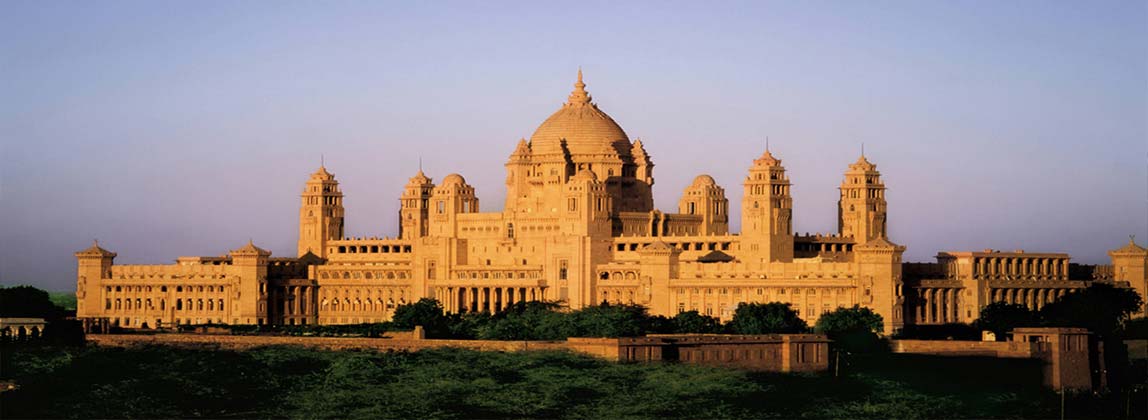


JODHPUR - The 'Blue City', as it is known, was founded on the edges of Thar Desert in 1459 A.D by Rao Jodha, a chief of the Rathore clan of the Rajputs.
Jodhpur is the second largest city in Rajasthan after Jaipur, and is encircled by a high 10 km long wall. The historic grandeur, exquisite handicrafts, folk dances, music and the brightly attired people lend an aura of romance to the city.
Flanked on its western side by the Meharangarh Fort, and on the eastern side by the stately sandstone Palace of Umaid Bhawan; the monuments, temples and gardens of Jodhpur depict a multi-faceted grandeur. The beauty and the imagination that have gone into the making of this monumental city proclaim the life-springs of creative genius that appear incongruent with harshness of this land and its climate.
The Bishnoi's are a community of Rajasthan who are famous for their rich cultural Rajasthani Life and there true love for nature and animals. A memorable outing in jeeps will lead you to various traditional village seeing in order to witness local handicrafts viz shoe makers, pottery hand weaving and also men in their traditional attire, women clad with ancestral silver Jewellery, en?route watch and photograph wildlife black buck, chinkaras, peacock etc. freely moving in abundance protected by "Bishnois" Protectors of wildlife and tree.
Located adjacent to Mehrangarh Fort is Jaswant Thada, the graceful marble cenotaph of Maharaja Jaswant Singh II. His son Maharaja Sardar Singh built this monument known as the Taj Mahal of Marwar in the memory of Maharaj Jaswant Singh II of Jodhpur. The main memorial has been built like a temple with intricately carved marble stone. A visit to this structure is through the rocky hills giving it a secluded and a mystic aura.
Mandore is located about 5 miles north of Jodhpur. It was the former capital of Maharajas of Marwar. Later it was abandoned for security concerns regarding the Mehrangarh fort. Its extensive Mandore garden, with high rock terrace, makes it a popular local attraction. In the Mandore garden, there are cenotaphs of Jodhpur's former rulers. Instead of the usual chhatri-shaped cenotaphs typical of Rajasthan, the cenotaphs of the famous Mandore garden of Jodhpur, Rajasthan are built along the lines of a Hindu temple. They are four stories high, with fine columns and an elegant spire, all in red sandstone.
It is about 5km from Jodhpur Town. Guarding the city below, the fort was founded by Rao Jodha in 1459 AD when he shifted his capital from Mandore. It overlooks the rugged and rocky terrain and houses a palace intricately adorned with long carved panels and latticed windows exquisitely wrought from red sandstone. The apartments within, have their own magic -the Moti mahal (Pearl Palace), Phool Mahal (Flower Palace), Sheesh Mahal (Mirror Palace), Daulat Khana with a rich varied collection of palanquins, howdas, royal cradles, miniature paintings of various schools etc.
Mehrangarh fort is about 5km from Jodhpur Town. Guarding the city below, crowning a perpendicular cliff, the fort was founded by Rao Jodha in 1459 AD when he shifted his capital from Mandore. Standing sentinel to the city below, it over looks the rugged and rocky terrain and houses a palace intricately adorned with long carved panels and latticed windows exquisitely wrought from red sandstone.
The apartments within, have their own magic -the Moti mahal (Pearl Palace), Phool Mahal (Flower Palace), Sheesh Mahal (Mirror Palace), Sileh Khana and Daulat Khana with a rich varied collection of palanquins, howdas, royal cradles, miniature paintings of various schools, folk music, instruments, costumes, furniture and an impressive armoury.
The display of cannons on the ramparts near Chamunda temple is among the rarest in India. As you climb up, folk musicians revive the grandeur of a bygone era.
Built by Maharaja Umaid Singh (1929 – 1942) and named after him, this exquisite Palace is also known as Chittar Palace because of the local chittar sandstone used in it. It is a splendid example of Indo-colonial and art deco architecture of the 30s. A unique feature of this palace is the fact that the manually chiseled sandstone blocks have been put together in a special system of interlocking. There is no mortar binding. A portion of the palace has been converted into a hotel, the other remains on view to visitors in the form of an excellent museum.